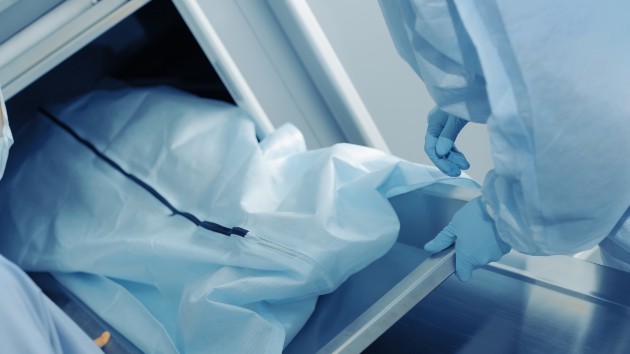
sudok1/iStock(NEW YORK) — Just as first responders have been working hard to treat and prevent the spread of the novel coronavirus, another group of medical staff have been working hard as last responders: medical examiners.
Medical examiners, also called forensic pathologists, are doctors who undergo intensive training to examine dead bodies to determine the likely cause of death.
What most people know about medical examiners comes from TV shows like CSI. However, you can’t always believe what you see on TV, Dr. Judy Melinek, M.D., a forensic pathologist who works in the San Francisco Bay Area, notes.
“The biggest misconceptions stem from the way television shows make it seem like we only get involved in homicides,” says Melinek. “Homicides are only about 10% of the cases we examine. The remaining 90% are a mixture of natural deaths, accidents and suicides.”
Dr. Melissa Guzzetta, D.O., a medical examiner based in New Jersey, tells ABC News, “I think the biggest misconceptions of medical examiners is that we have no respect for the deceased and are morbid people that like to ‘cut up’ bodies.”
Death investigations tend to be underfunded, while lower pay, high workload, minimal visibility and lack of acknowledgement from the general public dissuade many from the field.
There are around 500 full-time, board-certified forensic pathologists in the U.S., according to the National Commission on Forensic Science. But experts estimate that based on the size of the U.S. population, we need 1,100 to 1,200 in order to adequately handle the demand for forensic autopsies, the National Commission on Forensic Science has said.
“We all have our reasons for choosing this field,” Guzzetta said. “Mine came from a history of abuse with no one willing to advocate for me. Now, I get to speak for people that no longer have a voice.”
Some are motivated by the role forensic pathology plays in public health, as medical examiners report trends in causes of death, which shapes regulations that can improve public health and safety.
“This role is particularly important in assessing the death toll of the COVID-19 pandemic,” Melinik said.
Just as the pandemic has seemingly affected every aspect of life in America, medical examiner offices are also adjusting. This is especially true as, Guzzetta said, everyone involved in solving a death — from investigators and police at the scene to body transporters, morgue technicians and medical examiners — may be unknowingly exposed to COVID-19.
She adds, “We certainly want to minimize the risk of exposure as much as possible to all employees. So in most offices, that means less autopsies are being done, less staff and doctors are being utilized at any given time, and resources are being conserved for cases that need to be investigated further. There is also a limited amount of testing available for postmortem examination, restricting medical examiners/coroner offices in their investigations.”
On top of all that, some offices also have to worry about conserving PPE.
“We have changed our schedule into two teams so that there is no overlap between doctors,” says Melinek. “That way if one of us gets infected, we are less likely to spread it to everyone else at the office. We are socially distancing at work: using video meetings and phone calls to communicate, wearing masks and staying 6 feet away from one another, unless we are fully gowned in the morgue. We have converted our records to electronic formats to reduce transmission paperwork between the doctors, deputies and secretarial staff.”
Melinek said everyone in her San Francisco office also gets a temperature check at the front door, and the office has temporarily banned non-essential visitors.
Perhaps one of the most striking changes is the presence of refrigeration trucks to store the bodies of the deceased.
“Most of the COVID-19 cases will likely occur in a hospital setting, but we may be tasked with helping them with storage and disposition of remains if their morgues overflow,” Melinek said.
Guzzetta added, “Most hospital morgues are not suitable to hold more than a handful of bodies at a time so this has put a huge stress on hospitals that now need to have special teams for decedent management, to keep track of decedents and their personal effects.”
Along with managing decedents, forensic pathologists daily face one of the most emotionally difficult tasks that doctors perform — consoling those left behind.
“I try to put myself in the shoes of the family member, knowing that I am the last person to have seen their family member and in a way like no other,” Guzzetta said. “Sometimes they just want someone to listen, sometimes they need to hear that it’s not their fault, and sometimes they have questions that I may or may not be able to answer, but I always try and I am always honest. Sometimes when they cry, I cry.”
Optimistically she adds, “On any given day, I am fully aware of how lucky I am to live another day, to have my family and my health, and I make it a point not spend too much time on the trivial things.”
While the job of a last responder is often arduous, there are things every individual can do to help ease the burden. Melinek pointed out that choices we each make have a profound impact on those around us and across the nation.
“This virus is being transmitted by asymptomatic and presymptomatic individuals,” Melinek said. “By staying at home, washing your hands and wearing masks in public, you can shut it down. All of us who are working on the front lines of health care are counting on you to do that so we have fewer deaths.”
Copyright © 2020, ABC Audio. All rights reserved.
